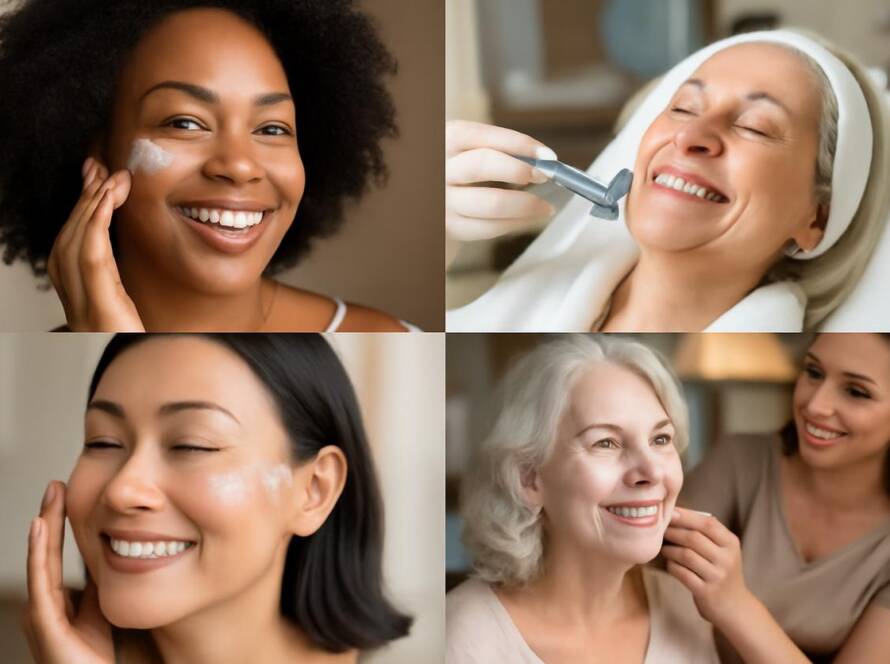A Practical Guide to Natural Skin Care Remedies: Evidence, Safety, and At-Home Recipes
Table of Contents
- Introduction: Why Thoughtful Natural Remedies Matter
- Skin Basics: Understanding Your Canvas
- How Evidence Supports Common Natural Ingredients
- Ingredient Safety Profiles: Knowledge is Power
- Step-by-Step At-Home Protocols and Recipes
- Weekly Care Plans by Skin Type
- Patch Testing and When to Stop: A Safety Checklist
- Troubleshooting Common Reactions
- When Natural Care Is Not Enough: Red Flags
- Quick Reference: Your Routine Checklist
- Evidence and Further Reading
Introduction: Why Thoughtful Natural Remedies Matter
The interest in natural skin care remedies has grown significantly as more people seek gentle, accessible, and sustainable ways to care for their skin. Using ingredients from your kitchen or garden can be both empowering and effective, but it requires a thoughtful approach. “Natural” does not automatically mean “safe for everyone.” This guide is designed to bridge the gap between popular at-home remedies and scientific evidence, helping you make informed decisions for your skin’s health. We will explore the science behind popular ingredients, provide safe, step-by-step protocols, and clarify when it is best to seek professional advice. Our goal is to empower you with practical, evidence-based knowledge to build a safe and effective natural skincare routine.
Skin Basics: Understanding Your Canvas
Before applying any remedy, understanding your skin’s fundamental workings is key. Effective natural skin care supports your skin’s inherent functions rather than working against them.
The Skin Barrier: Your First Line of Defense
Your skin’s outermost layer, the stratum corneum, is often called the skin barrier. Think of it as a wall made of skin cells (the bricks) and lipids (the mortar). A healthy barrier keeps moisture in and harmful irritants, allergens, and bacteria out. When this barrier is compromised, your skin can become dry, red, itchy, and sensitive. The best natural skin care remedies work to protect and repair this vital barrier.
The Skin Microbiome: A Delicate Ecosystem
Your skin is home to trillions of microorganisms, including bacteria, fungi, and viruses, that make up the skin microbiome. A balanced microbiome helps protect against pathogens and educates your immune system. Harsh treatments can disrupt this balance, leading to issues like acne and eczema. Gentle, pH-appropriate natural remedies can help maintain this delicate ecosystem.
Matching Remedies to Your Skin Type
Identifying your skin type is the first step in choosing the right ingredients. Using a remedy designed for oily skin on dry skin can cause irritation, and vice-versa. Here is a simple guide:
| Skin Type | Characteristics | Ideal Ingredient Focus |
|---|---|---|
| Dry | Feels tight, flaky, may have fine lines. | Humectants (honey, aloe), and Occlusives (shea butter, jojoba oil). |
| Oily | Looks shiny, has visible pores, prone to blackheads. | Lightweight hydrators (aloe), and ingredients that balance sebum (green tea). |
| Combination | Oily T-zone (forehead, nose, chin) with normal or dry cheeks. | Multi-masking; use different ingredients for different areas. |
| Sensitive | Reacts easily, prone to redness, itching, or stinging. | Soothing and anti-inflammatory ingredients (colloidal oatmeal, aloe vera). |
| Acne-Prone | Experiences frequent breakouts, can be oily or dry. | Antimicrobial and anti-inflammatory ingredients (honey, green tea, turmeric). |
How Evidence Supports Common Natural Ingredients
Many traditional remedies have been validated by modern research. Here is a look at some of the most well-supported natural skin care remedies and the science behind them.
Honey: Nature’s Humectant and Antimicrobial
Raw honey, particularly Manuka honey, is a powerful humectant, meaning it draws moisture into the skin. It also has natural antimicrobial and anti-inflammatory properties, making it beneficial for wound healing and managing acne-prone skin. Studies have shown its effectiveness in inhibiting bacterial growth, which is why it is often used in medical settings.
Colloidal Oatmeal: The Ultimate Soother
Colloidal oatmeal is finely ground oats suspended in liquid. It is rich in compounds like avenanthramides, beta-glucans, and phenols, which have anti-inflammatory and antioxidant properties. It is scientifically recognized for its ability to soothe dry, itchy skin associated with conditions like eczema and psoriasis by helping to restore the skin barrier.
Aloe Vera: Cooling and Hydrating
The clear gel from the aloe vera plant is over 99% water and contains vitamins, enzymes, and amino acids. It is well-known for its cooling and hydrating properties, making it a go-to for soothing sunburns. Research confirms its ability to promote healing and reduce inflammation.
Green Tea: A Polyphenol Powerhouse
Green tea is rich in polyphenols, particularly epigallocatechin gallate (EGCG), a potent antioxidant. Topically, green tea can help protect the skin from UV damage, reduce inflammation, and may even help reduce sebum production, making it a great choice for oily and acne-prone skin types.
Turmeric: The Anti-Inflammatory Spice
Curcumin, the active compound in turmeric, is a powerful anti-inflammatory and antioxidant. It has been studied for its potential to calm skin conditions like psoriasis and acne. However, it can stain the skin, so it should be used in small, diluted amounts in masks.
Botanical Oils: A Guide to Facial Oils
Plant-based oils can help lock in moisture and deliver antioxidants. Choose an oil based on its fatty acid profile. For example, jojoba oil is structurally similar to human sebum and is great for most skin types. Rosehip oil is rich in vitamins A and C, beneficial for scars and signs of aging.
Ingredient Safety Profiles: Knowledge is Power
Using natural ingredients requires an awareness of potential risks. Safety should always be your top priority when creating at-home remedies.
Understanding Allergens and Irritants
Just because an ingredient is natural does not mean it is hypoallergenic. Common allergens include certain essential oils (like lavender and tea tree), citrus fruits, and even some botanicals. Always perform a patch test before applying a new ingredient to your face.
The Golden Rule of Dilution
Essential oils are highly concentrated and should never be applied directly to the skin. A safe dilution for facial application is typically 0.5% to 1%, which translates to 3 to 6 drops of essential oil per 30ml (one ounce) of a carrier oil like jojoba or sweet almond oil.
Step-by-Step At-Home Protocols and Recipes
Here are some simple, effective recipes for natural skin care remedies you can make at home. Always use fresh ingredients and clean utensils.
DIY Face Masks: Recipes and Application
- Soothing Oatmeal Mask (for dry or sensitive skin): Mix 2 tablespoons of colloidal oatmeal with enough water or aloe vera gel to form a paste. Apply to clean skin, leave on for 10-15 minutes, and rinse with lukewarm water.
- Hydrating Honey and Aloe Mask (for all skin types): Combine 1 tablespoon of raw honey with 2 tablespoons of pure aloe vera gel. Apply a thin layer to your face, let it sit for 20 minutes, and rinse.
- Balancing Green Tea and Clay Mask (for oily or acne-prone skin): Mix 1 tablespoon of bentonite or kaolin clay with 2 tablespoons of cool, strongly brewed green tea. Add a pinch of turmeric powder (optional). Apply, avoiding the eye area. Rinse off just before it fully dries to prevent dehydration.
Weekly Care Plans by Skin Type
Consistency is crucial for seeing results. Here are sample weekly plans incorporating at-home treatments.
- Oily and Acne-Prone Skin: Use a balancing clay mask 1-2 times per week. A honey spot treatment can be used as needed.
- Dry and Dehydrated Skin: Apply a hydrating oatmeal or honey mask 2-3 times per week. Follow with a nourishing botanical oil.
- Combination Skin: Practice multi-masking. Use a clay mask on your T-zone and a hydrating mask on your cheeks once a week.
- Sensitive Skin: Use a soothing colloidal oatmeal compress or mask 1-2 times per week, or as needed to calm irritation.
Patch Testing and When to Stop: A Safety Checklist
A patch test is non-negotiable when trying new natural skin care remedies. It helps you identify potential adverse reactions before they become widespread.
How to Perform a Patch Test Correctly
- Prepare the Mixture: Create a small amount of the remedy exactly as you plan to use it.
- Apply to a Discreet Area: Apply a small dab to a discreet patch of skin, like your inner arm or behind your ear.
- Wait and Observe: Leave the mixture on for the recommended time (e.g., 15 minutes for a mask) or, if it is a leave-on product, cover it with a bandage and wait 24 hours.
- Check for Reactions: After the time is up, rinse the area. Monitor the spot for at least 24-48 hours for any signs of redness, itching, swelling, or blistering. If any of these occur, do not use the ingredient.
Troubleshooting Common Reactions
If you experience a mild reaction like slight redness or itching after using a remedy, stop using it immediately. Cleanse the area gently with a mild cleanser and cool water. Apply a simple, bland moisturizer or a cool compress made with colloidal oatmeal. If the reaction is severe or does not improve within a day, consult a healthcare professional.
When Natural Care Is Not Enough: Red Flags
While many skin concerns can be managed with gentle care, some issues require professional diagnosis and treatment. Natural remedies are not a substitute for medical care.
Red Flags: When to See a Professional
Consult a dermatologist or your doctor if you experience any of the following:
- Severe, painful, or cystic acne.
- A rash that is spreading, blistering, or showing signs of infection (pus, warmth).
- Persistent dryness, flaking, or redness that does not improve.
- Any new or changing moles.
- Symptoms that are impacting your quality of life.
For more information on when to seek professional help, organizations like the American Academy of Dermatology and the NHS provide reliable guidance on various skin conditions.
Quick Reference: Your Routine Checklist
To make your journey with natural skin care remedies easier, consider creating a one-sheet guide. On a single page, list your skin type, your chosen recipes with exact measurements, and a weekly schedule. Include a section for notes where you can track how your skin responds to each remedy. This personalized approach helps you build a routine that is truly yours.
Evidence and Further Reading
Being an informed consumer is the most important part of any skincare journey. Be critical of claims and look for evidence to support them. Websites that aggregate scientific studies are invaluable tools for evaluating the efficacy of different ingredients and treatments.
For those interested in diving deeper into the research behind skincare ingredients, here are some excellent, non-commercial resources:
- PubMed: A vast database of biomedical literature from the U.S. National Library of Medicine.
- Cochrane Reviews: A global independent network that gathers and summarizes the best evidence from research.
- DermNet NZ: An authoritative online resource all about the skin, provided by dermatologists.
By combining the wisdom of traditional remedies with the rigor of modern science, you can create a safe, effective, and enjoyable natural skincare routine that celebrates and supports your skin’s health for years to come, with strategies that will remain relevant well into 2025 and beyond.



